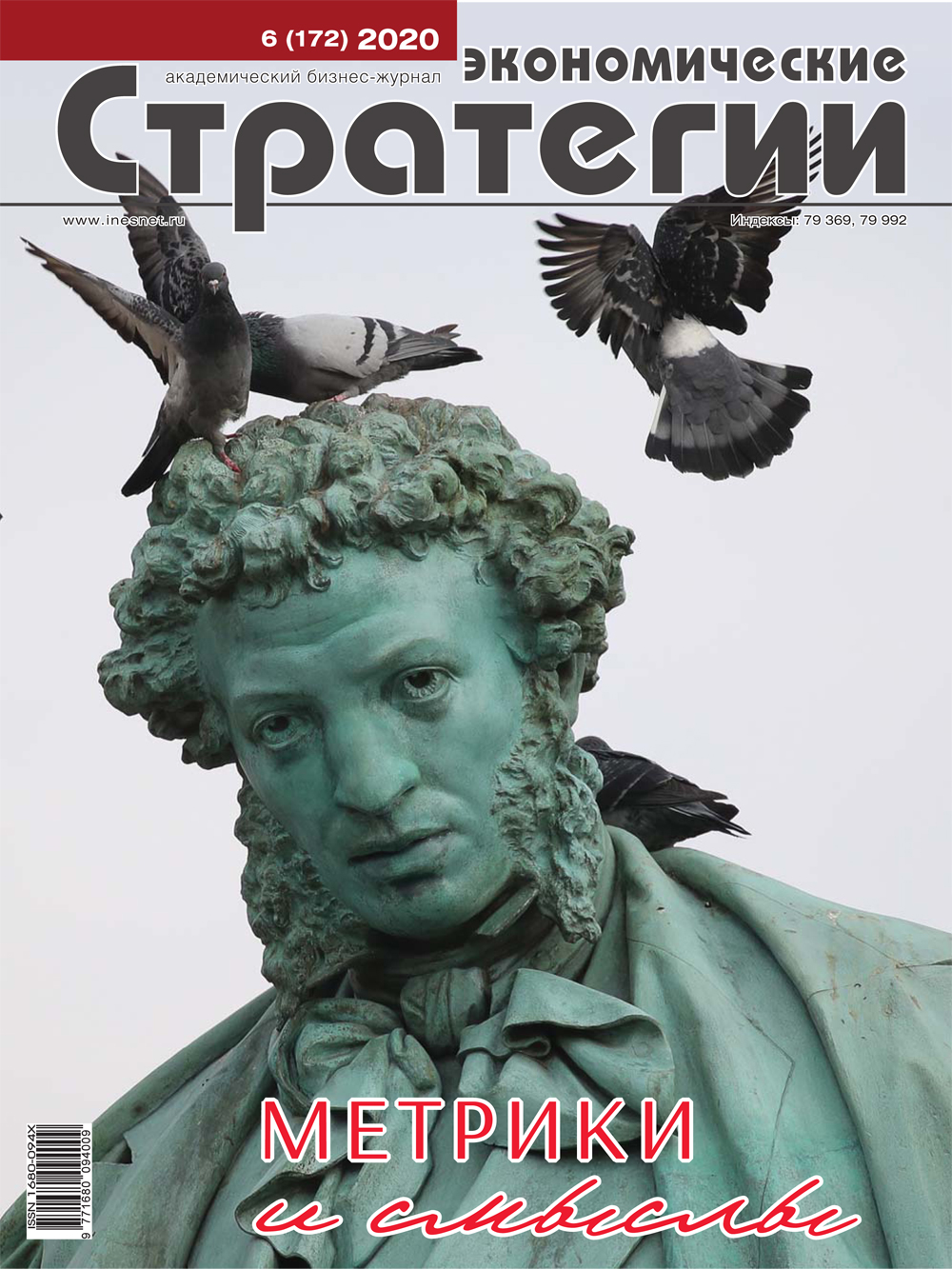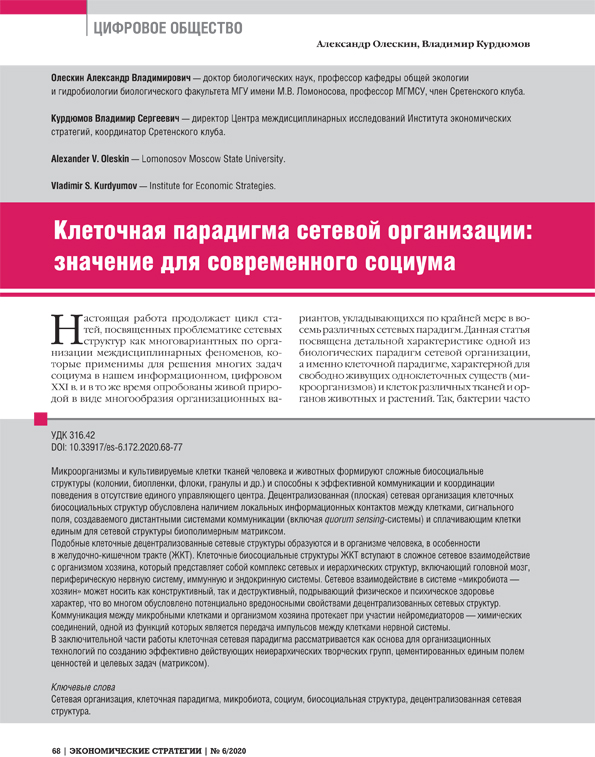Cellular Paradigm of Network Organization: Implications for Present-Day Society
DOI: 10.33917/es-6.172.2020.68-77
Microorganisms and cultivated cells from human or animal tissues form complex network structures (colonies, biofilms, flocs, granules, etc.) that are characterized by efficient communication and behavior coordination in the absence of a central pacemaker. The decentralized (flat) network organization of such structures is due to the functioning of (a) information-transmitting intercellular contacts, (b) a signal field created by distant communication systems, including the quorum-sensing system; and (c) a biopolymer matrix that cements the cells of the whole network structure. Microbial network structures exist in the human organism, especially in the gastro-intestinal (GI) tract. The cellular networks engage in complex interaction with the host organism. The organism represents a complex combination of hierarchical structures and decentralized networks and includes the brain, the peripheral nervous system, the immune system, and the endocrine system.
The interaction between the microbiota and the host may produce both positive and negative effects on the host’s physical and mental health, because decentralized networks are known to possess not only useful but also potentially harmful properties. Communication between microbial cells and the host organism involves neurochemicals, i.e., chemical compounds, whose functions include impulse transmission between nervous cells. In the final section, the cellular paradigm of network organization is envisaged as the conceptual basis of organizational technology aimed at creating efficient non-hierarchical creative teams that are cemented by common values and goals (the network matrix).
References:
1. Samoilov V.I., Vasil’ev Yu.M. Mekhanizmy sotsial’nogo povedeniya tkanevykh kletok pozvonochnykh; kul’tural’nye modeli [Mechanisms of Social Behavior of Vertebrate Tissue Cells; Cultural Models]. Zhurnal obshchei biologii, 2008, no 3, pp. 239–244.
2. Smirnov S.G. Etologiya bakterii [Ethology of Bacteria]. Ivanovo: Ivanovskaya gosudarstvennaya meditsinskaya akademiya, 2004.
3. Shapiro J.A. The significances of bacterial colony patterns. BioEssays, 1995, vol. 17(7), pp. 597–607.
4. Duan K.M., Dammel C., Stein J., et al. Modulation of Pseudomonas aeruginosa gene expression by host microflora through interspecies communication. Molecular Microbiology, 2003, vol. 50, pp. 1477–1491.
5. Leoni L., Rampioni G. Preface. Quorum Sensing: Methods and Protocols. Eds. L. Leoni, G. Rampioni, Rome, Humana Press, 2018, pp. vii–viii.
6. Oleskin A.V. Biosotsial’nost’ odnokletochnykh (na materiale issledovanii prokariot) [Biosociality of Unicellular Organisms (Based on Research on Prokaryotes)]. Zhurnal obshchei biologii, 2009, no 3, pp. 225–238.
7. Oleskin A.V., Malikina K.D., Shishov V.A. Symbiotic Biofilms and Brain Neurochemistry. Hauppauge, N.Y., Nova Science Publ., 2010.
8. Parashar A., Udayabanu M. Gut microbiota regulates key modulators of social behavior. European Neuropsychopharmcology, 2016, vol. 26, pp. 78–91.
9. Murrison R. Is there a role for psychology in ulcer disease? Integrative Psychological and Behavioral Science, 2001, vol. 36, no 1, pp. 75–83.
10. Oleskin A.V. Setevye struktury v biosistemakh i chelovecheskom obshchestve [Network Structures in Biosystems and Human Society]. Moscow, URSS, 2012.
11. Oleskin A.V. Setevoe obshchestvo: ego neobkhodimost’ i vozmozhnye strategii postroeniya [Network Society: the Need for It and Possible Strategies for Its Construction]. Moscow, URSS, 2016.
12. Oleskin A.V. Network Structures in Biological Systems and in Human Society. Hauppauge, N.Y., Nova Science Publ., 2014.
13. Verbrugge E., Boyen F., Gaastra W., et al. The complex interplay between stress and bacterial indections in animals. Veterinary Microbiology, 2012, vol. 155, pp. 115–127.
14. Norris V., Molina F., Gewirtz A.T. Hypothesis: bacteria control host appetites. Journal of Bacteriology, 2013, vol. 195, pp. 411–416.
15. Oleskin A.V., El’-Registan G.I., Shenderov B.A. Mezhmikrobnye khimicheskie vzaimodeistviya i dialog mikrobiota — khozyain: rol’ neiromediatorov [Intermicrobial Chemical Interactions and the Microbiota-host Dialogue: the Role of Neurotransmitters]. Mikrobiologiya, 2016, no 1, pp. 1–24.
16. Oleskin A.V., Shenderov B.A., Rogovsky V.S. Role of neurochemicals in the interaction between the microbiota and the immune and the nervous system of the host organism. Probiotics and Antimicrobial Proteins, 2017, vol. 9(3), pp. 215–234.
17. Montiel-Castro A.J., Gonzalez-Cervantes R.M., Bravo-Ruiseco G., Pacheco-Lopez G. The microbiota-gut-brain axis: neurobehavioral correlates, health and sociality. Frontiers in Integrative Neuroscience, 2013, vol. 7, available at: https://doi.org/10.3389/fnint.2013.00070.
18. Vinogradskii S.N. Eksperimental’nyi sotsializm [Experimental Socialism]. Letopis’ nashei zhizni. Moscow, MAKS Press, 2013, pp. 606–622.
19. Kuramoto Y. Chemical Oscillations, Waves, and Turbulence. N.Y., Springer-Verlag, 1984.
20. Andreev D. Roza mira [Rose of the World]. Moscow, Prometei, 1991.
21. Oleskin A.V., Kurdyumov V.S. Detsentralizovannye setevye struktury v nauchnom soobshchestve, sisteme obrazovaniya, grazhdanskom obshchestve i biznese: model’ khiramy [Decentralized Network Structures in the Scientific Community, the Education System, Civil Society and Business: Hirama Model]. Ekonomicheskie strategii, 2018, no 2, pp. 104–121.
22. Brown L.L., Acevedo B., Fisher H.E. Neural correlates of four broad temperament dimensions: testing predictions for a novel construct of personality. Plos One, 2013, doi.org/10.1371/journal.pone. 0078734.



